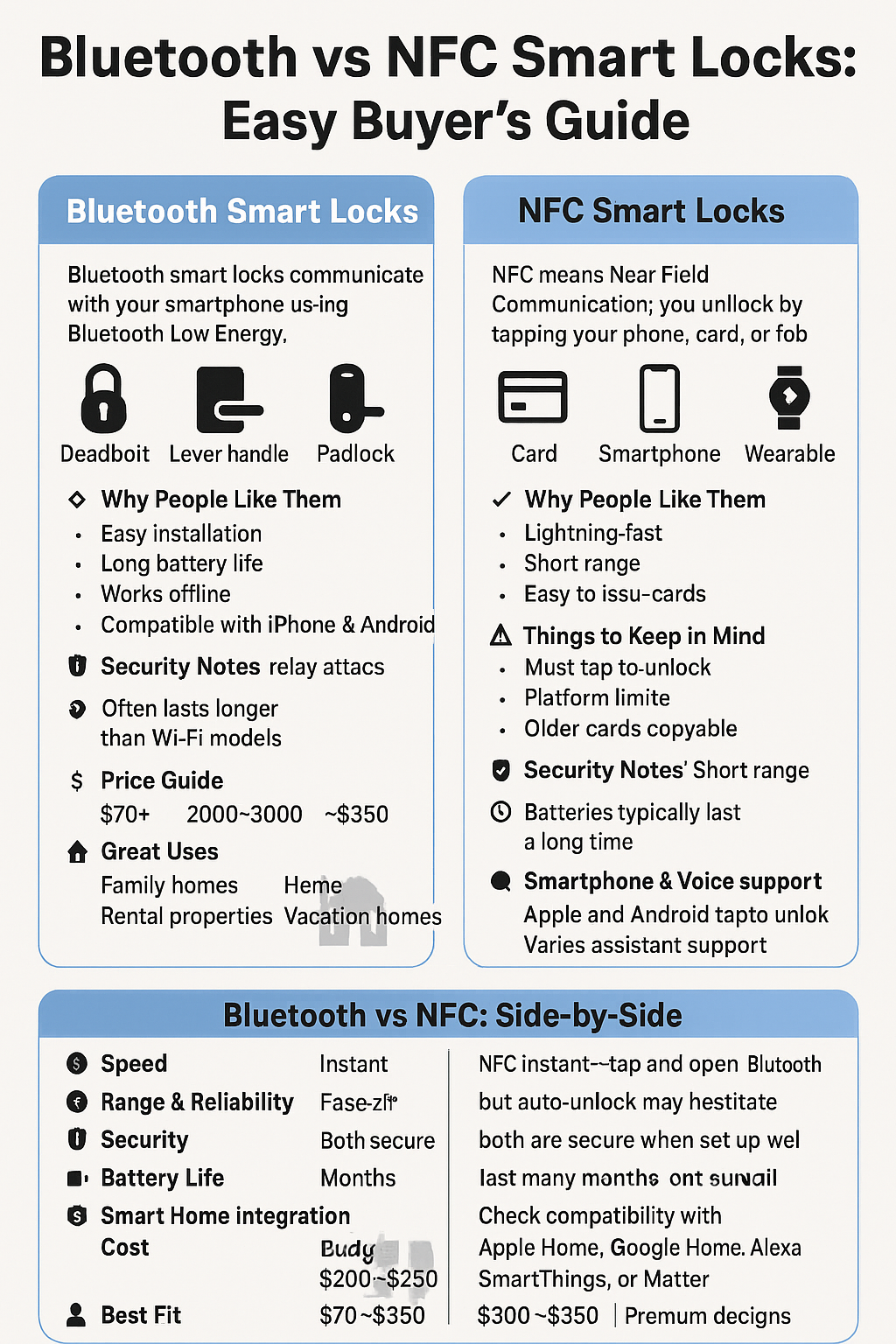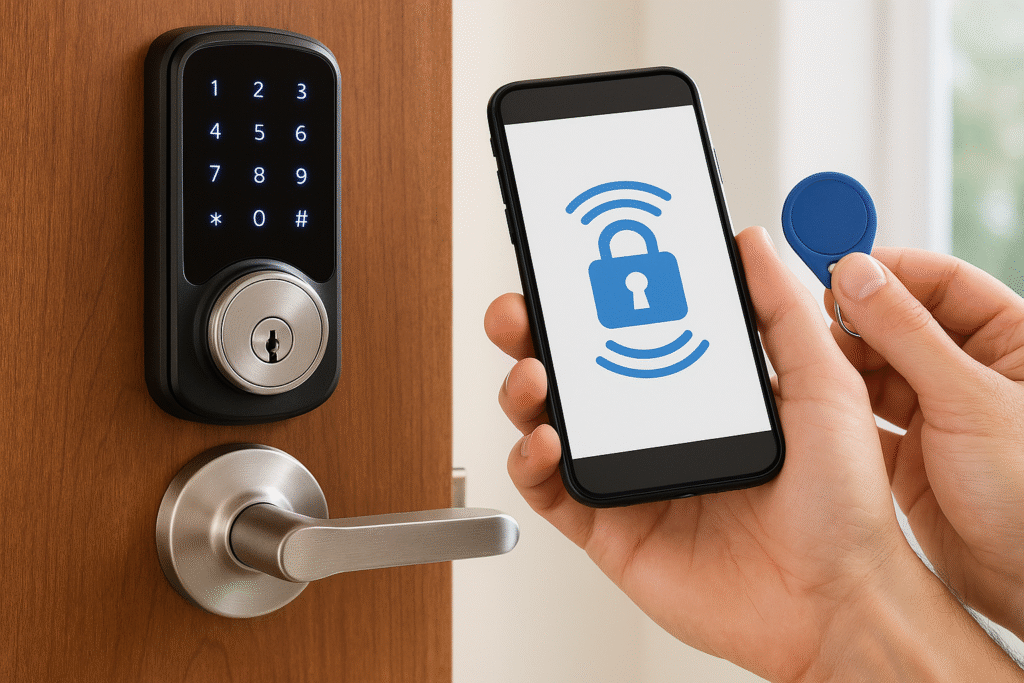Introduction
Choosing a smart lock can feel a bit like picking a new phone or car. There are so many features and shiny promises that it’s easy to get overwhelmed. But the idea is simple: you want a door that keeps you safe and opens when you need it—without juggling keys.
This guide breaks down Bluetooth smart locks and NFC smart locks in plain language. We’ll explore top brands, real user reviews, installation tips, pros and cons, security features, battery life, prices, and how each type fits into homes, rentals, offices, and vacation properties.
Imagine you’re coming home with arms full of groceries or luggage. With a smart lock, you don’t fumble for keys. You just walk up or tap your phone, and the door clicks open. The only question is which tech—Bluetooth or NFC—matches your daily routine.

Bluetooth Smart Locks
What They Are
Bluetooth smart locks talk directly to your phone using Bluetooth Low Energy. Many can add Wi-Fi with a small plug-in bridge. You’ll see them as deadbolts, lever handles, and padlocks. Well-known brands include Schlage, Yale, Level, August, Eufy, Ultraloq, Kwikset, and Master Lock.
Types
- Deadbolt locks replace or retrofit your current deadbolt—ideal for front doors.
- Lever handle locks combine the handle and lock in one piece—handy for side doors or home offices.
- Padlocks protect sheds, storage units, gates, or lockers.
- Many offer keyless entry with a keypad, fingerprint reader, or auto-unlock when your phone gets close.
Why People Like Them
- Easy installation: Most take less than an hour and only need a screwdriver.
- Long battery life: Six months to a year is typical if you don’t use Wi-Fi all the time.
- Works offline: Local phone-to-lock control means no internet required.
- Compatible with both iPhone and Android through each brand’s app.
Things to Keep in Mind
- Auto-unlock can sometimes lag if your phone’s Bluetooth is asleep.
- Range is only a few meters and can shrink through thick walls.
- Remote control usually needs an extra Wi-Fi bridge.
Security Notes
Modern Bluetooth locks use strong encryption such as AES. The biggest risks are relay attacks (tricking the lock into thinking your phone is nearby) and weak app passwords. Stay safe by locking your phone with a strong passcode, enabling firmware updates, and limiting auto-unlock to trusted areas.
Battery Life
Bluetooth uses very little power. Locks that stay on Bluetooth only often last longer than Wi-Fi-only models.
Smartphone & Voice Support
Most work with iOS and Android apps. Many also connect to Apple Home, Google Home, Alexa, or SmartThings. For voice commands and full remote access, you usually need a hub or built-in Wi-Fi.
Price Guide
- Budget Bluetooth deadbolts: about $70.
- Midrange: $200–$300.
- Premium designs: around $350.
Quick Install Steps
- Check door thickness and deadbolt hole size.
- Remove old hardware.
- Mount the new lock, connect the cable, and attach the interior piece.
- Insert batteries, run auto-calibration, and pair it in the app.
- Set PIN codes, enable auto-lock, and allow firmware updates.
Great Uses
- Family homes where you want auto-unlock and PINs for kids.
- Rental properties to send time-limited codes to guests.
- Vacation homes when paired with a Wi-Fi bridge for remote access.
- Commercial spaces where phones and codes are easier than keys.
NFC Smart Locks
What They Are
NFC means Near Field Communication, the same tech behind tap-to-pay cards. Here you unlock by tapping your phone, watch, card, fob, or even some wearables against the reader. iPhone calls this Home Key inside Apple Wallet. Android support for tap-to-unlock is growing fast, and a new standard called Aliro will soon make it easier across all brands.
Types
- Card-based systems used in offices and apartment buildings.
- Smartphone tap-to-unlock where your phone stores a secure key.
- Wearable NFC devices such as watches or NFC rings.
Why People Like Them
- Lightning-fast: A simple tap and you’re in.
- Short range: You must be at the door, reducing accidental unlocks.
- Easy to issue cards or fobs for guests, cleaners, or employees.
Things to Keep in Mind
- You must physically tap—no hands-free auto-unlock.
- Platform limits: Apple Home Key is polished on iPhone and Apple Watch; Android tap support is still rolling out.
- Older NFC cards can be easy to copy—stick to modern ones.
Security Notes
Short range is a natural security boost. Use up-to-date credentials such as DESFire EV2 or newer to avoid cloning issues. Keep firmware updated and treat wallet keys like credit cards.
Battery Life
NFC readers only draw power during a tap, so batteries typically last a long time. If your lock also runs Wi-Fi or heavy motors for auto-locking, expect to swap batteries a bit sooner.
Smartphone & Voice Support
Apple and Android now both support tap-to-unlock on certain locks. Voice assistant support (Apple Home, Google Home, Alexa) varies by brand.
Price Guide
Most NFC-ready deadbolts cost $200–$350, though budget models exist.
Great Uses
- Offices or apartment buildings where cards and fobs are standard.
- Homes where you love tap-to-unlock convenience.
- Rental properties to give cleaners or guests NFC cards instead of keys.
- Vacation homes where guests can tap or use a PIN without downloading an app.
Bluetooth vs NFC: Side-by-Side
Speed
- NFC: Instant—tap and open.
- Bluetooth: Often quick, but auto-unlock may hesitate if your phone is slow to respond.
Range & Reliability
- Bluetooth: Works from several meters away, good for walk-up auto-unlock.
- NFC: Works only at touch distance, which is predictable and secure.
Security
Both are secure when set up well:
- Bluetooth: Uses strong encryption. Protect your phone and update firmware.
- NFC: Short range plus modern cards like DESFire make cloning difficult.
Battery Life
Both last many months. Bluetooth-only modes often outlast Wi-Fi smart locks, and NFC is efficient because it wakes only when tapped.
Smart Home Integration
Look for compatibility with Apple Home, Google Home, Alexa, SmartThings, or Matter. Apple Home Key uses NFC, and Android tap-to-unlock is expanding.
Cost
- Budget Bluetooth: around $70.
- Midrange Bluetooth or NFC: $200–$300.
- Premium designs: $300–$350.
Best Fit
- Bluetooth: Families who want hands-free auto-unlock or renters who need quick PINs.
- NFC: Tap-to-unlock fans, Apple Home Key users, or offices issuing cards and fobs.
Consumer Favorites
- Schlage Encode Plus: Apple Home Key and built-in keypad.
- Level Lock Pro: Sleek premium design with Home Key support.
- Yale Assure Lock 2 Plus: Trusted Yale design with Apple Home Key.
- Ultraloq Bolt NFC: Works with both Apple Home Key and Android tap-to-unlock.
- Budget Bluetooth picks like TP-Link Tapo show excellent battery life when used in Bluetooth-only mode.
Real-Life Snapshots
- Busy family: A Bluetooth deadbolt with keypad and auto-lock lets kids use PINs while parents enjoy hands-free unlocking—no more juggling groceries and keys.
- Rental host: A Bluetooth lock with a Wi-Fi bridge makes it simple to send time-limited PINs to guests and cleaners.
- Small office: NFC cards and phone taps allow the owner to quickly revoke access when contractors finish work.
Buying Checklist
- Check your door. Measure thickness and deadbolt hole size.
- Pick your style.
- Want walk-up auto-unlock? Go Bluetooth.
- Prefer a quick tap? Go NFC.
- Want walk-up auto-unlock? Go Bluetooth.
- Choose your ecosystem. Apple, Google, Alexa, or SmartThings.
- Plan for batteries. Keep spares and know how to use any emergency power option.
- Stay secure. Use strong phone passcodes, enable app alerts, and install firmware updates.
- Set your budget. $70–$150 entry-level, $200–$300 midrange, $300+ premium.
- Test and tweak. After installing, check codes, auto-lock timing, and door alignment.
What’s Coming Next
- Cross-platform tap-to-unlock thanks to standards like Aliro.
- Matter-ready locks for easier setup across different smart-home platforms.
- Ultra-Wideband (UWB) on premium models for precise, hands-free entry.
- Ongoing firmware updates to keep security strong.

Conclusion
Both Bluetooth and NFC smart locks can make life easier and safer. Bluetooth shines when you want auto-unlock, quick PIN sharing, and an easy install. NFC wins if you love lightning-fast tap-to-unlock and tight control at the door.
Ready to choose? Decide whether you’d rather unlock by walking up or by tapping. Measure your door, pick a trusted brand, and soon you’ll swap your old keys for a smoother, smarter welcome home.
